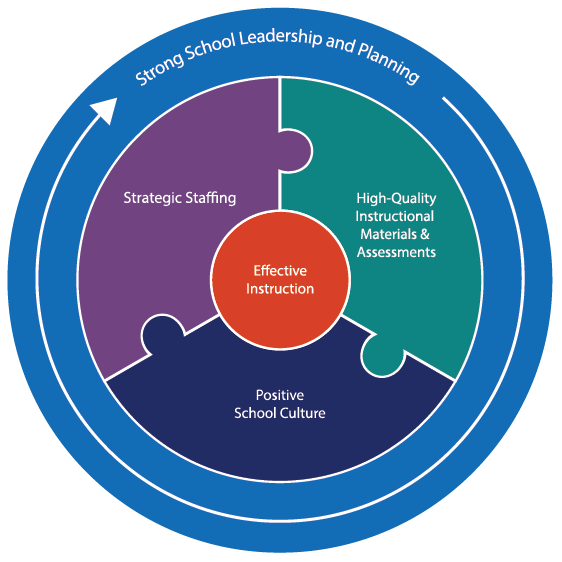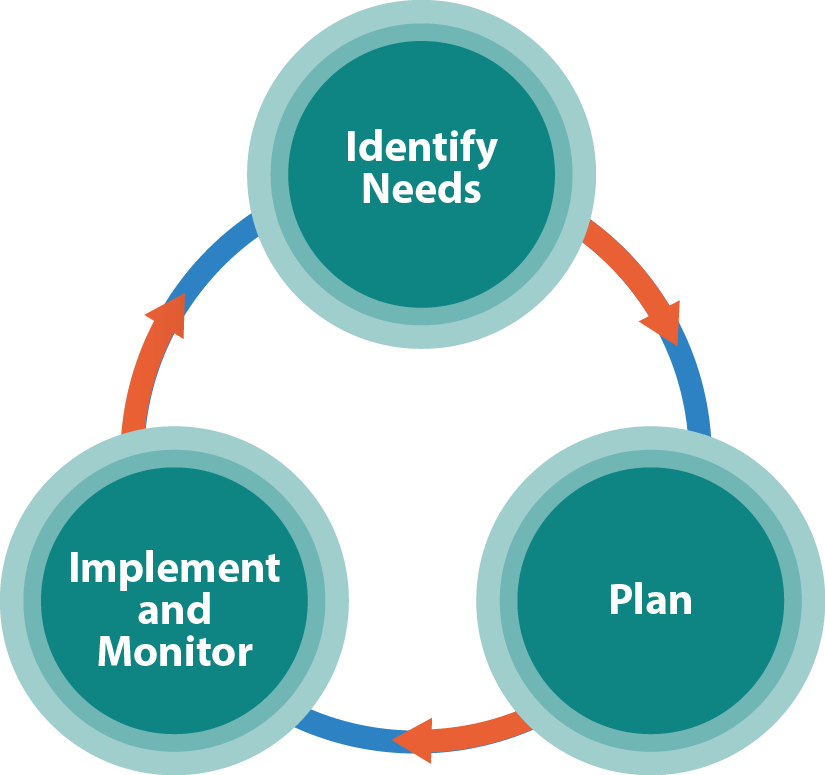The Effective Schools Framework (ESF) is a guide developed by the Texas Education Agency (TEA) to establish a clear vision for districts and schools across the state. The ESF recognizes best practices and describes specific actions that high performing districts and campuses implement.
The Effective Schools Framework contains several layers. First, there are 5 Prioritized Levers that are essential for high-performing campuses. Then, within each Lever, you will find District Commitments, Essential Actions, and Key Practices. Let’s take a look at what they are and how they all work together.
Components of the Effective Schools Framework

The following Prioritized Levers are the guiding principles that make up the foundation of a strong campus. They are the umbrella that everything else is under.
- Prioritized Lever 1 – Strong School Leadership and Planning
- Prioritized Lever 2 – Strategic Staffing
- Prioritized Lever 3 – Positive School Culture
- Prioritized Lever 4 – High-Quality Instructional Materials & Assessments
- Prioritized Lever 5 – Effective Instruction
District Commitments
Within each Prioritized Lever, the ESF outlines District Commitments. These describe what local education agencies (LEA), or districts, do to ensure that their campuses are set up for success. In order for campuses to be high-performing, it begins with the support and structures at the district level.
For example, here are a few of the District Commitments that should be in place for Prioritized Lever 1- Strong School Leadership and Planning.
- The district places its most effective school leaders in its highest need schools.
- The district recognizes the unique needs of low-performing schools and provides the flexibility to address those needs.
- The district supports principals by protecting their time dedicated for school instructional leadership.
Essential Actions
In addition, each Prioritized Lever includes Essential Actions (EA). The Essential Actions describe what the most effective schools do to support powerful teaching and learning. These also help build a common language around high leverage best practices across the state.
The first Essential Action listed under each Prioritized Lever is considered foundational. Campuses and districts seeking continuous improvement should address the foundational Essential Actions first, as they provide the foundation upon which the other essential actions develop. For example, here are some Essential Actions under Prioritized Lever 1- Strong School Leadership and Planning.
Essential Action 1.1 – Develop campus instructional leaders (principal, assistant principal, counselors, teacher leaders) with clear roles and responsibilities.
Essential Action 1.2 – Focused plan development and regular monitoring of implementation and outcomes.
Under Prioritized Lever 1, Essential Action 1.1 is considered foundational. Campuses must first establish clear roles and responsibilities for campus instructional leaders before they can focus on plan development and monitoring.
Key Practices
To further define the Essential Actions, the ESF includes specific Key Practices. These key practices illustrate what Essential Actions look like when implemented with fidelity on a campus. If we take a look at the Foundational Essential Action 1.1- Develop campus instructional leaders (principal, assistant principal, counselors, teacher leaders) with clear roles and responsibilities, we can see the Key Practices below:
- Campus instructional leaders have clear, written, and transparent roles and responsibilities, and core leadership tasks are scheduled on weekly calendars (observations, debriefs, team meetings).
- Performance expectations are clear, written, measurable, and match the job responsibilities.
- Campus instructional leaders use consistent, written protocols and processes to lead their department, grade-level teams, or other areas of responsibility.
- Campus instructional leaders meet on a weekly basis to focus on student progress and formative data.
- Principal improves campus leaders through regularly scheduled, job-embedded professional development consistent with best practices for adult learning, deliberate modeling, and observation and feedback cycles.
What is the ESF Diagnostic Process?

Districts and campuses seeking to support their organization in continuous improvement efforts can request an ESF Diagnostic through their local Education Service Center. The diagnostic process is a collaborative approach, using a third-party facilitator to help identify the highest leverage practices a campus can focus on for improvement.
In some cases, very talented principals are able to design and implement effective systems and processes, but once that leader moves on, the campus falls back into chaos. Through careful analysis, the ESF facilitator will assist campus leaders in providing clarity on whether systems and processes are systemic and practiced campus-wide. This is important so that no matter who holds the title of principal, the campus continues on a path of excellence.
Bring the ESF Diagnostic Process to your campus by emailing Adrienne King at adrienne.king@esc13.txed.net.
Elements of the ESF Diagnostic Process
The ESF diagnostic process focuses on six Essential Actions:
1.1- Developing campus instructional leaders (principal, assistant principal, teacher leaders, and counselors) with clear roles and responsibilities.
2.1- Recruiting, selecting, assigning, inducting, and retaining a full staff of highly qualified educators.
3.1- A compelling and aligned vision, mission, goals, values focused on a safe environment and high expectations.
4.1- Daily use of high-quality instructional materials aligned to instructional planning calendars and interim and formative assessments.
5.1- Effective classroom routines and instructional strategies.
5.3- Data-driven instruction.
Through evidence collection, focus group interviews, and campus observations, the ESF facilitator works side-by-side with the campus principal and the principal’s supervisor to determine 2–3 high-leverage focus areas for campus improvement. Finally, the ESF diagnostic process is for all schools wishing to fine-tune their plans for continuous improvement.
For more information on the Effective Schools Framework, visit: texasesf.org.
Updated March 2022





Add comment